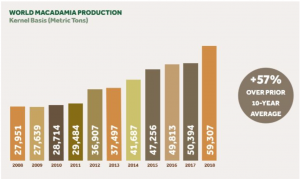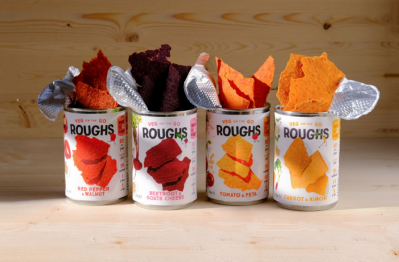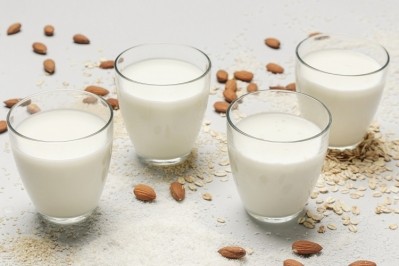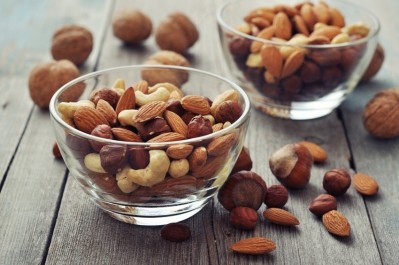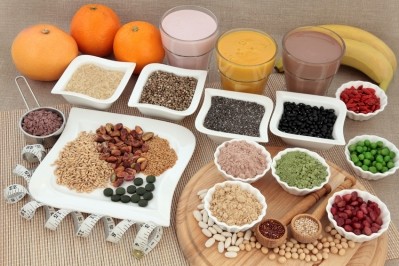A tough nut to crack: Macadamia firm explores innovations in the ingredient sector
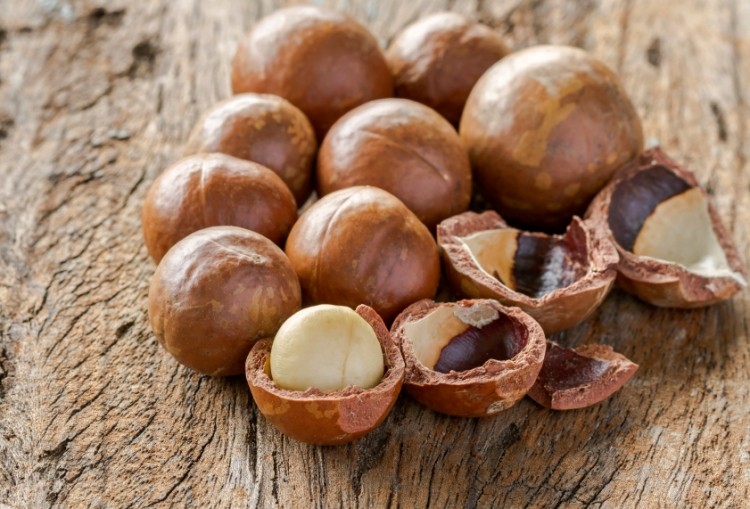
The marketer, which represents six different macadamia processors across five continents, has invested in an innovation programme to explore potential uses for macadamias as an ingredient. Results so far include a dairy-free mushroom soup, mango smoothie, drinkable yogurt and set yogurt – proving there is a tangible business possibility for macadamias as an ingredient that also delivers to healthy eating consumer demands, according to the firm.
“Other nuts such as almonds, walnuts and pistachios all started as ingredients but macadamias were introduced to the world as a snack item not an ingredient,” G&G CEO Brian Loader explained to FoodNavigator.
Macadamias are notoriously costly to harvest and grow because high quality nuts fall from only mature trees. They also reach full production in 12 to 15 years but can last up to 40 years.
But global supply has doubled in the past five years and will double again by 2023, according to the International Nut Council. Overall, global tree nut supply has grown by 47% in the last 10 years, with macadamias showing the largest growth at 57%.
Macadamias currently are still small in supply by comparison to other nuts, but this is changing rapidly, said Loader. A decade ago, he noted, it was a hard sell to convince people that macadamias could be produced on a big enough scale to use as ingredients.
“The size of our industry has probably been the biggest hurdle for our foray into the ingredient area because the volumes that one requires to get there are substantial. But now we are approaching the critical mass where using macadamias as an ingredient is becoming very interesting.”
What is most interesting about macadamias is the texture, said Loader. “The texture is universally loved with macadamias. It’s not hard like an almond; it’s not soft like a cashew; it’s different.”
Creamy textural advantage
Loader explained that the company began to experiment with the ingredient to understand the product better. It was only then it realised the texture of macadamias could give them an advantage over other dairy-free milk alternatives.
G&G focused testing to see if macadamias retained their creamy textural advantage as a liquid when used as a dairy replacement. It discovered that due to their high healthy fat content, macadamias have very high and stable emulsification properties. This meant little to no product separation together with the preservation of creamy texture. The neutral flavour (unlike coconut for example) makes way for a variety of uses, sweet, salty and otherwise.
“Up until recently we were nervous about testing that textural theory in very fine form in a paste or a butter that a confectioner or dairy company or cheese maker would use. We felt that we’d lose our identity,” explained Loader.
“What we’ve found is that its textural advantage does carry over. The smoothness, the butteryness, the full-bodiedness of macadamias translates to this format. That was a tremendous surprise to be honest.
“We’d never been in a format before where we were liquid and blended with something else.
"We just assumed that because of the high oil content of macadamias that when it was blended with something else it would separate. But it doesn’t.”
The company also found macadamias were an excellent flavour carrier, again due to their high fat content. Focus group findings supported that, from both taste and texture perspectives, participants could not tell that macadamia was used instead of milk for both the soup and the smoothie. The yoghurt texture resembled that of dairy yoghurt, but participants could taste that macadamias we used - for some that was positive, for others not.
“We tested the soup against the market leader in Brazil and it was preferred in a blind tasting test. We weren’t trying to beat anyone, we just wanted to see how macadamias performed as an ingredient in something hot,” noted Loader.
A unique but expensive nut
- Macadamia prices have risen 33% in value compared to last year
- Production up 57% the last 10 years
- Macadamia production forecast at 59,300 mt tonnes in 2019. Up 18% on 2017
- South Africa 29%, Australia 25%, Kenya 13%, China 10% are the leading growing regions
- US and China are the world’s largest consumers of macadamias
The macadamia industry is going through unprecedented change
“I’ve been in the macadamia industry for a while and I’ve always wanted to do this,” said Loader. "This has been a bit of a dream of mine personally. I love the fact that we’re learning. Every time we try and find out about something [about macadamias] we seem to find something quite new and unique.”
Cost, however, is a hurdle to overcome, he admitted.
“One of the challenges that we’re going to have to demonstrate is that macadamias – while they do have a unique selling proposition for food manufacturers that want to use our product in this sort of way – is that it’s probably going to be a more expensive option than the dairy alternative – you’re probably adding 10 cents to the cost of the soup.”
Macadamias as an ingredient
- Macadamias prove highly stable emulsification properties and retain creamy texture
- The neutral flavour and high fat content make macadamias an excellent flavour carrier
Capitalising on growing demand for plant-based ingredients
The recent EAT-Lancet commission findings further bolster its plans, said G&G’s. According to the report, nearly half (40%) of the recommended daily protein-calorie requirement should come from nuts, with legumes representing a further 40%. The remaining 20% suggested to optionally come from animal sources. Additionally, it estimates that currently, nuts have the lowest representation in what we consume daily, further illustrating the enormous untapped potential.
“We have long believed in the potential of macadamias - from their unique health, taste and textural benefits through to their perception of being rare and luxury. The G&G team is infinitely buoyed by what this initial foray into how the future looks for how macadamias are consumed. Increases in supply means the industry will no longer play second fiddle to the larger nut counterparts in this sector,” concluded Loader. “It is only a matter a time before macadamias take their rightful place alongside, and at times supersede, other nut counterparts in dairy alternatives, bakery, butters, pastes and others.”
